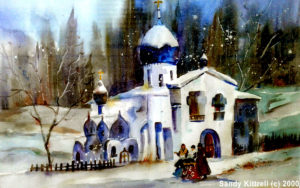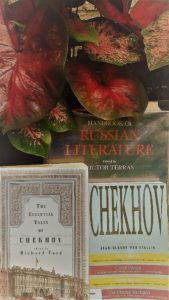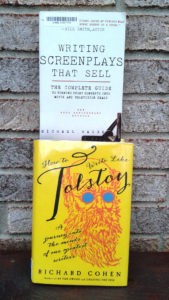(Context – Subtext – Intertextuality)
The author, Amor Towles, name drops in A Gentleman in Moscow. He weaves the names of literary greats, facts from the writers’ lives and passages from classics. A special surprise is the frequent mentioning of Chekhov and Tolstoy. I search for a term to describe this writing technique. No, it’s not plagiarism because the quotes are attributed to each author. By accident, between context for Bulgakov and subtext for Chekhov, I stumble on this little word – intertextuality.
Of course, it is not a little word, and the concept is huge in application. Intertextuality includes lifting and incorporating lines and thoughts from previously published works. It also expands to building upon previously published themes, characters and plots. Here is a reason for writers to be avid readers. To reference a previous work, the writer must have knowledgeable of the text within the writers’ work. Without a sufficient literary background, the modern writer misses the opportunity for deeper meaning. I struggle with merely achieving sufficient knowledge to find the hidden treasures of intertextuality in my reading.
Intertextuality
To find examples of intertextuality in A Gentleman in Moscow, I utilize technology to locate the passages. A simple “search” or “find” in the digital copy delivers numerous references for Chekhov, Tolstoy and even Bulgakov. Famous titles, such as War and Peace, enter the dialogue when one character is challenged to transcribe a favorite passage. And Anna Karenina is wedged under a furniture leg to steady a wobbly bureau.
One of my favorite references is in a footnote. Towles writes about what I encountered in reading Tolstoy and Chekhov. He writes that “among readers of European fiction the character names in Russian novels are notorious for their difficulty. Not content to rely on given and family names, we Russians like to make use of honorifics, patronymics, and an array of diminutives – such that a single character in one of our novels may be referred to in four different ways in as many pages. To make matters worse, it seems that our greatest authors, due to some deep-rooted sense of tradition or a complete lack of imagination constrained themselves to the use of thirty given names. You cannot pick up a work of Tolstoy, Dostoevsky, or Turgenev without bumping into an Anna, an Andrey, or an Alexander.”
Count the Many Ways
Speaking of Alexanders and multiple names, Count Alexander Ilyich Rostov– called Count, Alexander and Sasha — is the protagonist in A Gentleman in Moscow . In this fictional book, the Count is under house arrest and confined to the Metropol Hotel in 1922 for publishing a poem unacceptable to the newly empowered Communist party. The abdication of Nicholas II, the Bolshevik Revolution, civil war in Russia and War World I were only a few years in the past. The Count, a descendent of Russian aristocracy with ties to the former Tsar, has lost seemingly everything. The following passage by Towles describes the downfall of aristocrats, writers and politicians.
” . . . the Confederacy of the Humbled is a close-knit brotherhood whose members travel with no outward markings, but who know each other at a glance. For having fallen suddenly from grace, those in the Confederacy share a certain perspective. Knowing beauty, influence, fame, and privilege to be borrowed rather than bestowed, they are not easily impressed. They are not quick to envy or take offense. They certainly do not scour the papers in search of their own names. They remain committed to living among their peers, but they greet adulation with caution, ambition with sympathy, and condescension with an inward smile.”
Literally Literary
The character, Mikhail Mindich, a boyhood friend of the Count, mentions Chekhov and is in the process of editing a compilation of Chekhov’s letters. In one scene, Mishka (nickname) shares his frustration at being forced to delete part of a letter by Anton Chekhov to his sister. Although Chekhov’s letter was written in 1904, the 1930s in Russia and the Great Purges (1936-1938) eliminated anything counter-revolutionary or negative about Russia. Towles includes the letter sent from Chekhov in Berlin on June 6, 1904 to his sister, Masha. Only a month before his death, Chekhov comments on the good German bread, his improving health and the quality of his hotel.
As you might guess, Mishka is eventually imprisoned as an Enemy of the People. Following his imprisonment, Mishka writes a book titled Bread and Salt. Towles includes passages about bread from Genesis, Matthew and Luke and by authors Nikolai Gogol, Ivan Turgenev, Ivan Goncharov, Fyodor Dostoevsky, Leo Tolstoy and Anton Chekhov. The passages inspire me to find these stories and novels to read next and better understand the effect of intertextuality in this example. Curious about the reference to bread and salt, I discover this is a welcoming custom in Russian for guests or on special occasions. Perhaps the Count’s reading Mishka’s book is the special occasion or a reference to a shared greeting in their more pleasant past as young men.
This novel accomplishes the job of putting history in context with literature. Towles, a reader of Russian literature, confirms the importance of Tolstoy and Chekhov in the history of world literature. I also learn through the events portrayed in the novel the cultural and political sentiment for Mikhail Bulgakov during the time when he wrote The Master and Margarita.
Now, I know enough about Russian literature to be dangerous.




